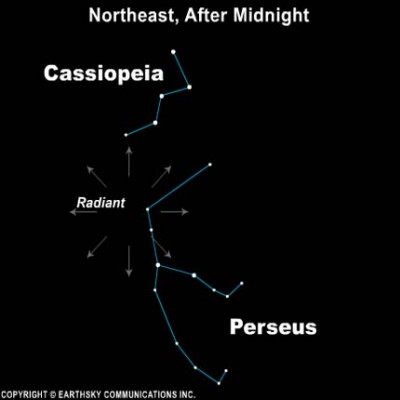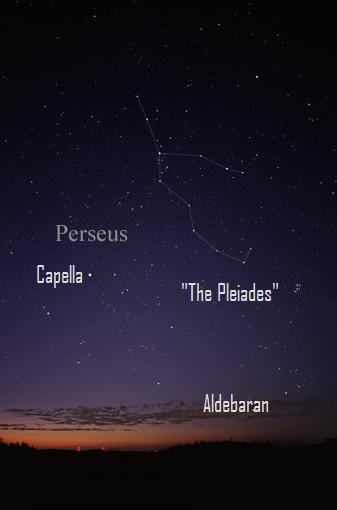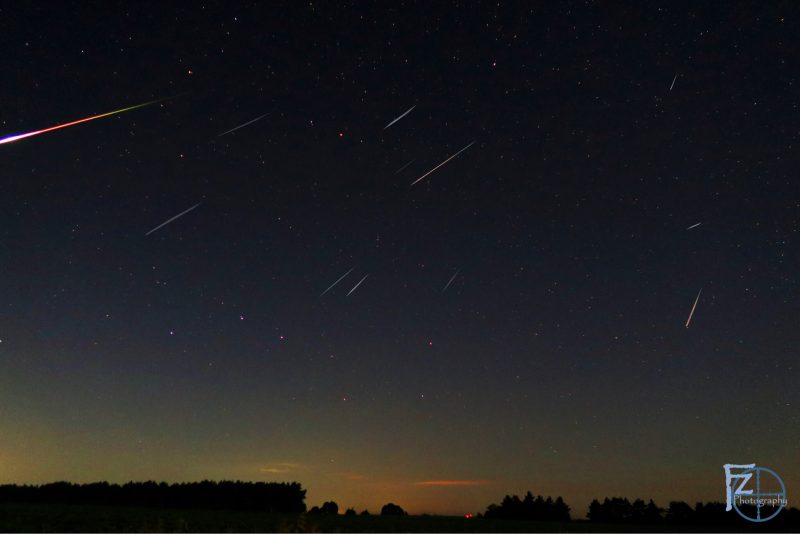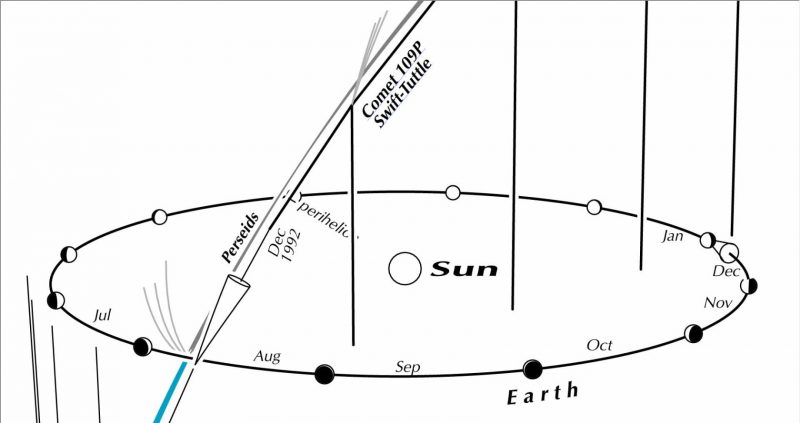
The beloved Perseid meteor shower
In the Northern Hemisphere, we rank the August Perseids as our all-time favorite meteor shower. The Perseids take place during the lazy, hazy days of northern summer, when many families are on vacation. And what could be more luxurious than taking a siesta from the heat of the day and watching this summertime classic in the cool of night? Plus, 2021 is an excellent year for this shower! No matter where you live worldwide, the 2021 Perseid meteor shower will probably produce the greatest number of meteors on the mornings of August 11, 12 and 13. On the peak mornings in 2021 – in the early morning hours, when the most meteors will be flying – there’ll be no moon to ruin on the show. Here are a few tips to help you enjoy this shower.
1. No special equipment, or knowledge of the constellations, needed.
2. Find a wide-open sky. These meteors will all come from a single point in the sky, their radiant point. More about that below. But, as you stand watching (and depending on what time of the night it is), you’ll see meteors streak across the sky in front of numerous constellations. A wide-open sky will give you the best show.
3. Watch from midnight to dawn. That’s when the part of Earth you’re standing on will be heading into the meteor stream in space. So you’ll see more meteors. By dawn, they’ll be raining down from overhead. Be aware that the Perseid meteors will start to fly in mid-to-late evening from northerly latitudes. South of the equator, the Perseids start to streak the sky around midnight. Here’s an added bonus for evening observing. If fortune smiles upon you, the evening hours might offer you an earthgrazer, a looooong, slow, colorful meteor traveling horizontally across the evening sky. Earthgrazer meteors are rare but memorable. Perseid earthgrazers appear before midnight, when the radiant point of the shower is close to the horizon.
4. You want a dark sky for watching meteors. In a dark sky, you may see up to 60 meteors per hour at the shower’s peak. Will you see over 100 per hour, as in some years? Perhaps. But you won’t know unless you look. To find a dark sky near you, check out EarthSky’s worldwide Best Places to Stargaze map.
5. Give yourself at least an hour of observing time, because the meteors in meteor showers come in spurts and are interspersed with lulls. Remember, your eyes can take as long as 20 minutes to adapt to the darkness of night. So don’t rush the process.
6. Enjoy the comfort of a reclining lawn chair. Bring along some other things you might enjoy also, like a thermos filled with a hot drink.
7. If you must watch in moonlight, place yourself in the moon’s shadow. In 2021, the moon will be in a waxing crescent phase, setting in the west in early evening, as the Perseids peak. So the moon won’t be a factor for the Perseids’ peak this year. But maybe you want to start watching for Perseids in late July, when there’s a moon in the sky between midnight and dawn? If so, place some large structure or natural object – a barn, a cabin, a mountain – between you and the moon. You’ll see more meteors that way than if you’re standing out under the blazing moonlight itself.
8. Consider watching after the peak. People tend to focus on the peak mornings of meteor showers, and that’s entirely appropriate. But meteors in annual showers – which come from streams of debris left behind in space by comets – typically last weeks, not days. Perseid meteors usually start streaking the sky around July 17. They rise gradually to a peak, then fall off more rapidly. Still, we’ll see some Perseids – though at considerably reduced numbers – for some days after the peak mornings on August 11, 12 and 13.
9. Remember, all good things come to those who wait. Meteors are part of nature. There’s no way to predict exactly how many you’ll see on any given night. Find a good spot, watch, wait. You’ll see some.
10. Also remember, as the Perseids are rising to their peak, the Delta Aquariid meteor shower will still be rambling along steadily. You’ll see mostly Perseids, but also some Delta Aquariids in the mix. There’s an explanation of how to tell the difference toward the bottom of this article.
Perseid meteor shower radiant point
If you trace all the Perseid meteors backward, they all seem to come from the constellation Perseus, near the famous Double Cluster. Hence, the meteor shower is named in honor of the constellation Perseus the Hero.
However, this is a chance alignment of the meteor shower radiant with the constellation Perseus. The stars in Perseus are light-years distant while these meteors burn up about 60 miles (100 km) above the Earth’s surface. If any meteor survives its fiery plunge to hit the ground intact, the remaining portion is called a meteorite. Few – if any – meteors in meteor showers become meteorites, however, because of the flimsy nature of comet debris. Most meteorites are the remains of asteroids.
In ancient Greek star lore, Perseus is the son of the god Zeus and the mortal Danaë. It is said that the Perseid shower commemorates the time when Zeus visited Danaë, the mother of Perseus, in a shower of gold.
Read more about the radiants for the Perseids and Delta Aquariids




Comet Swift-Tuttle and the Perseids
Every year, from around July 17 to August 24, our planet Earth crosses the orbital path of Comet Swift-Tuttle, the parent of the Perseid meteor shower. Debris from this comet litters the comet’s orbit, but we don’t really get into the thick of the comet rubble until after the first week of August. The bits and pieces from Comet Swift-Tuttle slam into the Earth’s upper atmosphere at some 130,000 miles (210,000 km) per hour, lighting up the nighttime with fast-moving Perseid meteors.
If our planet happens to pass through an unusually dense clump of meteoroids – comet rubble – we’ll see an elevated number of meteors. We can always hope!
Comet Swift-Tuttle has a very eccentric – oblong – orbit that takes this comet outside the orbit of Pluto when farthest from the sun, and inside the Earth’s orbit when closest to the sun. It orbits the sun in a period of about 133 years. Every time this comet passes through the inner solar system, the sun warms and softens up the ices in the comet, causing it to release fresh cometary material into its orbital stream.
Comet Swift-Tuttle last reached perihelion – closest point to the sun – in December 1992 and will do so next in July 2126.

Bottom line: The 2021 Perseid meteor shower is expected to produce the most meteors in the predawn hours of August 11, 12 and 13, in a dark, moonless sky. Here’s how to get the most from this year’s shower.
EarthSky’s 2021 meteor shower guide
Everything you need to know: Delta Aquariid meteor shower
The post Perseid meteor shower 2021: All you need to know first appeared on EarthSky.
from EarthSky https://ift.tt/3rxafyg

The beloved Perseid meteor shower
In the Northern Hemisphere, we rank the August Perseids as our all-time favorite meteor shower. The Perseids take place during the lazy, hazy days of northern summer, when many families are on vacation. And what could be more luxurious than taking a siesta from the heat of the day and watching this summertime classic in the cool of night? Plus, 2021 is an excellent year for this shower! No matter where you live worldwide, the 2021 Perseid meteor shower will probably produce the greatest number of meteors on the mornings of August 11, 12 and 13. On the peak mornings in 2021 – in the early morning hours, when the most meteors will be flying – there’ll be no moon to ruin on the show. Here are a few tips to help you enjoy this shower.
1. No special equipment, or knowledge of the constellations, needed.
2. Find a wide-open sky. These meteors will all come from a single point in the sky, their radiant point. More about that below. But, as you stand watching (and depending on what time of the night it is), you’ll see meteors streak across the sky in front of numerous constellations. A wide-open sky will give you the best show.
3. Watch from midnight to dawn. That’s when the part of Earth you’re standing on will be heading into the meteor stream in space. So you’ll see more meteors. By dawn, they’ll be raining down from overhead. Be aware that the Perseid meteors will start to fly in mid-to-late evening from northerly latitudes. South of the equator, the Perseids start to streak the sky around midnight. Here’s an added bonus for evening observing. If fortune smiles upon you, the evening hours might offer you an earthgrazer, a looooong, slow, colorful meteor traveling horizontally across the evening sky. Earthgrazer meteors are rare but memorable. Perseid earthgrazers appear before midnight, when the radiant point of the shower is close to the horizon.
4. You want a dark sky for watching meteors. In a dark sky, you may see up to 60 meteors per hour at the shower’s peak. Will you see over 100 per hour, as in some years? Perhaps. But you won’t know unless you look. To find a dark sky near you, check out EarthSky’s worldwide Best Places to Stargaze map.
5. Give yourself at least an hour of observing time, because the meteors in meteor showers come in spurts and are interspersed with lulls. Remember, your eyes can take as long as 20 minutes to adapt to the darkness of night. So don’t rush the process.
6. Enjoy the comfort of a reclining lawn chair. Bring along some other things you might enjoy also, like a thermos filled with a hot drink.
7. If you must watch in moonlight, place yourself in the moon’s shadow. In 2021, the moon will be in a waxing crescent phase, setting in the west in early evening, as the Perseids peak. So the moon won’t be a factor for the Perseids’ peak this year. But maybe you want to start watching for Perseids in late July, when there’s a moon in the sky between midnight and dawn? If so, place some large structure or natural object – a barn, a cabin, a mountain – between you and the moon. You’ll see more meteors that way than if you’re standing out under the blazing moonlight itself.
8. Consider watching after the peak. People tend to focus on the peak mornings of meteor showers, and that’s entirely appropriate. But meteors in annual showers – which come from streams of debris left behind in space by comets – typically last weeks, not days. Perseid meteors usually start streaking the sky around July 17. They rise gradually to a peak, then fall off more rapidly. Still, we’ll see some Perseids – though at considerably reduced numbers – for some days after the peak mornings on August 11, 12 and 13.
9. Remember, all good things come to those who wait. Meteors are part of nature. There’s no way to predict exactly how many you’ll see on any given night. Find a good spot, watch, wait. You’ll see some.
10. Also remember, as the Perseids are rising to their peak, the Delta Aquariid meteor shower will still be rambling along steadily. You’ll see mostly Perseids, but also some Delta Aquariids in the mix. There’s an explanation of how to tell the difference toward the bottom of this article.
Perseid meteor shower radiant point
If you trace all the Perseid meteors backward, they all seem to come from the constellation Perseus, near the famous Double Cluster. Hence, the meteor shower is named in honor of the constellation Perseus the Hero.
However, this is a chance alignment of the meteor shower radiant with the constellation Perseus. The stars in Perseus are light-years distant while these meteors burn up about 60 miles (100 km) above the Earth’s surface. If any meteor survives its fiery plunge to hit the ground intact, the remaining portion is called a meteorite. Few – if any – meteors in meteor showers become meteorites, however, because of the flimsy nature of comet debris. Most meteorites are the remains of asteroids.
In ancient Greek star lore, Perseus is the son of the god Zeus and the mortal Danaë. It is said that the Perseid shower commemorates the time when Zeus visited Danaë, the mother of Perseus, in a shower of gold.
Read more about the radiants for the Perseids and Delta Aquariids




Comet Swift-Tuttle and the Perseids
Every year, from around July 17 to August 24, our planet Earth crosses the orbital path of Comet Swift-Tuttle, the parent of the Perseid meteor shower. Debris from this comet litters the comet’s orbit, but we don’t really get into the thick of the comet rubble until after the first week of August. The bits and pieces from Comet Swift-Tuttle slam into the Earth’s upper atmosphere at some 130,000 miles (210,000 km) per hour, lighting up the nighttime with fast-moving Perseid meteors.
If our planet happens to pass through an unusually dense clump of meteoroids – comet rubble – we’ll see an elevated number of meteors. We can always hope!
Comet Swift-Tuttle has a very eccentric – oblong – orbit that takes this comet outside the orbit of Pluto when farthest from the sun, and inside the Earth’s orbit when closest to the sun. It orbits the sun in a period of about 133 years. Every time this comet passes through the inner solar system, the sun warms and softens up the ices in the comet, causing it to release fresh cometary material into its orbital stream.
Comet Swift-Tuttle last reached perihelion – closest point to the sun – in December 1992 and will do so next in July 2126.

Bottom line: The 2021 Perseid meteor shower is expected to produce the most meteors in the predawn hours of August 11, 12 and 13, in a dark, moonless sky. Here’s how to get the most from this year’s shower.
EarthSky’s 2021 meteor shower guide
Everything you need to know: Delta Aquariid meteor shower
The post Perseid meteor shower 2021: All you need to know first appeared on EarthSky.
from EarthSky https://ift.tt/3rxafyg

Aucun commentaire:
Enregistrer un commentaire